To go straight to why newsletters kill sales, jump to this section.
To go straight to the 6am hack, jump to this section.
To go straight to the 5-part email series that attract clients to you, jump to this section.
–
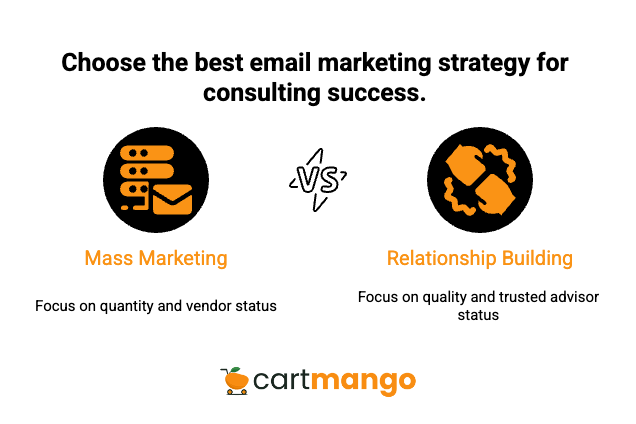
What works for e-commerce stores destroys consulting relationships.
Most consultants treat email marketing like a numbers game. Send more emails, get more clients, right? Wrong. This approach turns you from trusted advisor into just another vendor cluttering people’s inboxes.
The most successful consultants send fewer emails than their struggling competitors. They focus on relationship building instead of mass marketing tactics.
This guide gives you a proven 30-day system. You’ll discover how to position yourself as the expert people actually want to hear from.
Week 1: Email Foundation
Your email foundation determines everything that follows. Get this wrong and you’ll spend months fixing problems that could have been prevented in three hours.
For email marketing platforms, you can use BirdSend or Mailchimp.
Unlike Mailchimp though, BirdSend is built specifically for solo consultants, coaches, and creators who prioritize relationships over mass marketing. The interface doesn’t overwhelm you with enterprise features you’ll never use.
Building Your Email List
Create your lead magnet. One free consultation or diagnostic tool works better than generic whitepapers for consultants. People want solutions, not more reading material.

Website Signup Forms: Create a prominent email signup form on your website offering your lead magnet. Use clear language about what subscribers will receive and how often.
Consultation Request Forms: Every consultation request becomes an opt-in opportunity. Include checkbox language like “Yes, I’d like to receive strategic insights and industry updates via email.”
Speaking Engagement Sign-ups: Collect emails from audience members who want your presentation materials or follow-up resources. Always include opt-in language.
Networking Event Follow-ups: When someone gives you their business card and requests follow-up information, that’s your opt-in moment. Send a follow-up email asking for permission to add them to your strategic insights list.
LinkedIn Connection Requests: After connecting on LinkedIn, send a message offering valuable content and asking if they’d like to receive your monthly strategic updates via email.
–
Create separate contact lists for different opt-in sources. This segmentation becomes crucial when you start sending targeted campaigns. Website subscribers might want different content than speaking event attendees.
Week 2: Your First Email Campaign
Most consultants schedule emails whenever it’s convenient for them. This misses the golden window when decision makers actually read their inbox.
Understanding when and how people consume email changes everything.
The “Value-First Introduction” Email Series
Email # | Send Day | Subject Line Template | Content Focus | Primary Goal | Psychology Factor |
|---|---|---|---|---|---|
1 | Monday (6-9am) | “The [Industry] challenge I see everywhere” | Problem identification + Your insight | Build credibility | Morning priority reading |
2 | Wednesday (6-9am) | “How [Client Type] solved this in 90 days” | Case study + Framework | Demonstrate expertise | Results-focused professionals |
3 | Friday (6-9am) | “Free tool: [Specific diagnostic/checklist]” | Valuable resource + Consultation offer | Generate leads | End-of-week planning mindset |
Space emails 48 hours apart. This prevents overwhelming prospects while maintaining momentum in your relationship building efforts.
Each email should feel like a personal communication from a trusted advisor. Avoid corporate speak and marketing jargon that screams “mass campaign.”
Psychology Insights
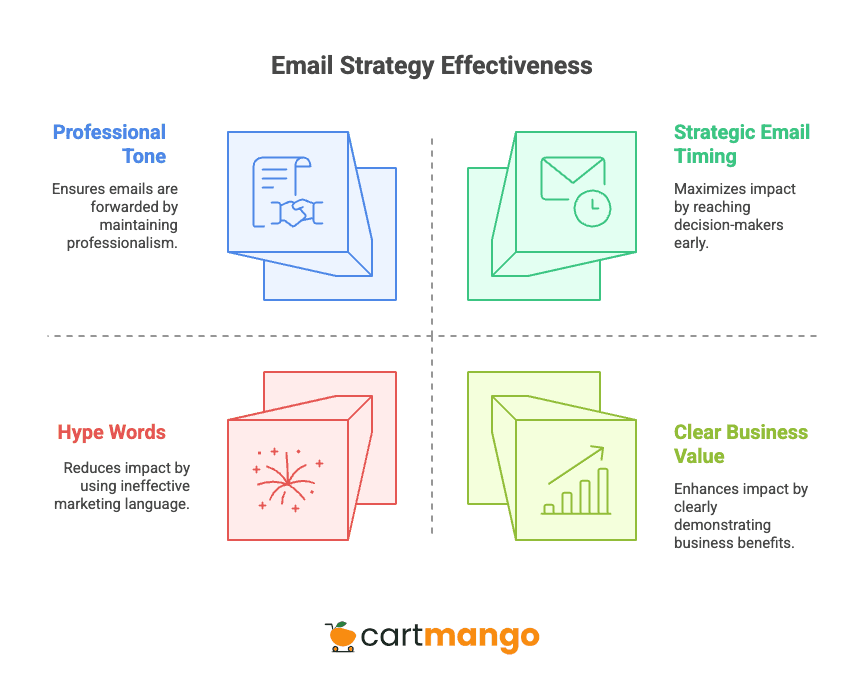
The 6am-9am window changes everything. Decision makers check email before their assistant filters messages and before meetings consume their day. Miss this window and your email gets buried under 50 other messages.
Subject line psychology for important business decisions works differently than consumer marketing. Avoid hype words like “explosive” or “revolutionary.” Focus on business impact and measurable outcomes instead.
The assistant factor can make or break your outreach. Write emails that get forwarded up the chain rather than filtered out at the gatekeeper level. Professional tone and clear business value pass the gatekeeper test.
Successful B2B email marketing case studies demonstrate how business leader communication patterns differ completely from general business communications (source).
Your first email should identify a problem that keeps business owners awake at night. Don’t pitch solutions yet. Build credibility by demonstrating that you understand their world at a deeper level than their internal team.
People’s attention spans are measured in seconds, not minutes. Get to the point quickly while maintaining respect for their intelligence and experience. They’ll appreciate directness over cleverness.
Week 3: Simple Automation Setup
Now it’s time to automate the processes that work. This transition from manual to automated communication maintains personal touch while scaling your efforts.
Here’s where most consultants get lost in complex workflows. I’ve seen people spend weeks building automations that should take 15 minutes.
The temptation to create elaborate sequences feels overwhelming. You imagine mapping out every possible prospect journey with perfect automation. This perfectionist approach kills momentum and delays implementation.
Email Automation #1: Consultation Follow-Up Sequence
Set this up once and it handles every consultation booking automatically:
Email # | Send Timing | Purpose | Key Content | Professional CTA |
|---|---|---|---|---|
1 | Immediate (auto-send) | Confirmation + Preparation | Meeting details + Strategic prep questions | “Please review these strategic questions” |
2 | Day before (8am) | Professional reminder | Meeting agenda + Outcome expectations | “Looking forward to our strategic discussion” |
3 | 1 hour after meeting | Follow-up + Authority | Thank you + Decision framework + Timeline | “Here’s your strategic roadmap and next steps” |
Setup takes 15 minutes in BirdSend’s automation builder. The sequence runs automatically for every new consultation booking.
Proven email automation workflow strategies help consultants nurture high-level relationships more effectively than manual follow-ups.
The confirmation email should include strategic questions that prepare decision makers for productive discussions. This positions you as someone who values their time and comes prepared.
Your reminder email reinforces professionalism while building anticipation. Include the meeting agenda and expected outcomes to demonstrate your structured approach.
The follow-up email within one hour shows responsiveness and captures momentum while the conversation remains fresh. Include next steps and timeline to maintain forward progress.
Automation #2: The 5-Part Welcome Email Series That Builds Trust
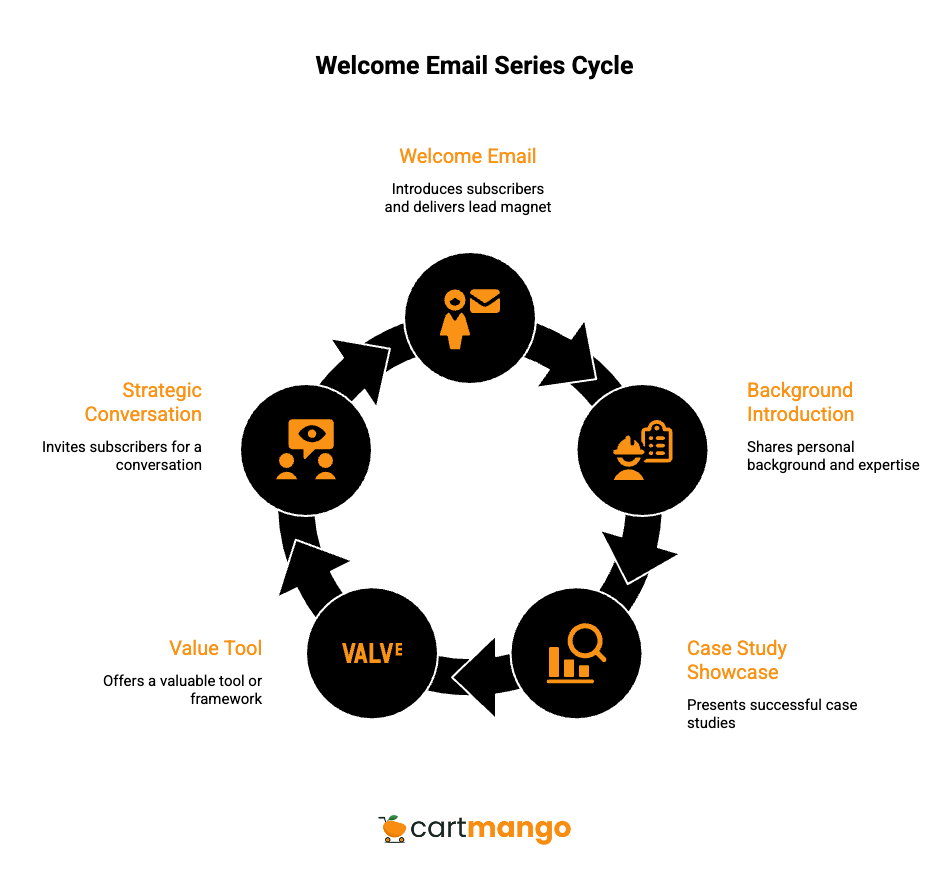
Create a 5-email welcome series that introduces new opt-in subscribers to your expertise:
- Email 1: Welcome + Lead magnet delivery
- Email 2: Your background + why you help [specific type] of business leaders
- Email 3: Case study showcasing typical results
- Email 4: Framework or tool that provides immediate value
- Email 5: Invitation to book a strategic conversation
Email 1: Welcome + Lead Magnet Delivery (Send Immediately)
Your first email confirms their subscription and delivers the promised lead magnet. Include a personal welcome message that sets expectations for what they’ll receive and how often.
Example:
“Hi [First Name], here’s the Strategic Planning Framework you requested after downloading it from my LinkedIn article about Q4 budget planning.”
The pain of subscribers who forget they signed up hurts. This email prevents that confusion while positioning you as someone who follows through on promises.
–
Email 2: Your Origin Story (Send Day 3)
Share your background and why you help their specific type of business leaders.
Example:
“3 years ago, I watched a $50M manufacturing company nearly collapse because their strategic planning process took 8 months and missed market shifts entirely. That’s when I developed the 90-day strategic pivot framework.”
This isn’t your resume. This is the story of how you discovered the problems they face and developed solutions that work. Personal connection builds faster than professional credentials.
Personalization tip: Reference their industry if known from signup form data.
–
Email 3: Social Proof Through Results (Send Day 5)
Showcase a case study with measurable outcomes.
Example:
“Sarah’s healthcare practice was losing $30K monthly to operational inefficiencies. Using the workflow optimization framework I shared last week, she recovered $25K within 60 days and now has time to focus on patient care instead of administrative chaos.”
Include enough detail that readers can envision themselves in similar situations.
Personalization tip: Choose case studies that match the subscriber’s company size or industry when possible.
–
Email 4: Immediate Value Framework (Send Day 7)
Provide a framework or diagnostic tool they can use right away.
Example:
“Today I’m sharing the 5-Question Business Health Assessment that takes 10 minutes but reveals whether you’re building sustainable growth or just staying busy.”
This email demonstrates your thinking process while giving them something actionable.
Personalization tip: Include industry-specific questions or examples within the framework.
–
Email 5: Strategic Conversation Invitation (Send Day 10)
Close the series with a soft invitation to book a consultation.
Example:
“Based on your downloads and email engagement, you seem focused on operational efficiency challenges. I have 3 strategic conversation slots open next week if you’d like to discuss your specific situation.”
Frame this as a strategic conversation rather than a sales call.
Personalization tip: Reference their behavior from previous emails (clicked links, downloaded resources) to make the invitation feel natural and relevant.
–
Advanced Personalization Tips:
- Tag subscribers by lead magnet source to customize industry references
- Use behavioral triggers (email opens, link clicks) to adjust messaging tone
- Reference their company size in examples when information is available
- Adjust frameworks and case studies based on their indicated challenges
Week 4: Results Tracking & List Building Optimization
With your campaigns running and automations working, measuring the right outcomes becomes critical. This final week of foundation building ensures you optimize for relationship quality over vanity metrics while growing your legitimate subscriber base.
Tracking the wrong metrics leads to bad decisions. Most email marketing advice focuses on open rates and click-through rates. These matter less for consultants than you think.
The mental gymnastics of justifying low open rates while your consultation calendar stays empty hurts.
Focus on metrics that connect directly to revenue generation and relationship building.
Track These 4 Metrics
1/ List Growth Rate: Track how many new opt-in subscribers you gain monthly. Aim for 10-15% monthly growth through lead magnets and speaking opportunities.
2/ Professional Engagement Rate: Measure replies and forwards from business leaders. This tells you if your content creates conversations rather than just consumption. Track the quality of responses, not just quantity.
3// Consultation booking rate from email subscribers tracks monthly conversion. This directly connects your email efforts to revenue generation. Calculate the ratio of consultation requests from email subscribers.
4/ Unsubscribe Rate: Keep this under 2%. Higher unsubscribe rates indicate content mismatch or too frequent sending. Exit surveys help identify improvement areas.
Professional services typically achieve higher email engagement rates than other industries due to the relationship-based nature of consulting businesses.
List Building Acceleration Tactics
1/ Social Content Strategy: Create valuable posts that drive traffic to your lead magnet signup page. Include clear calls-to-action directing readers to your email list.
2/ Speaking Opportunity Leverage: Every speaking engagement should generate 20-30 new opt-in subscribers. Create presentation-specific landing pages with relevant lead magnets.
3/ Strategic Partnership Referrals: Partner with non-competing consultants to cross-promote each other’s email lists to relevant audiences.
4/ Webinar Registration Lists: Host monthly webinars on strategic topics. Registration automatically opts people into your email list with proper disclosure.
The numbers tell a story, but don’t get obsessed with vanity metrics. One engaged Fortune 500 decision maker might be worth more than 1000 unengaged contacts.
Create a simple spreadsheet to track these metrics monthly. Note patterns in professional engagement and adjust your messaging accordingly. What works with technology leaders might fail with healthcare administrators.
Monthly Maintenance Plan
After completing your 30-day foundation, sustainable growth requires consistent but less ongoing effort. This maintenance approach prevents the email marketing overwhelm that kills consultant productivity.
Monthly Email Calendar (Professional-Focused Content)
Week | Content Type | Professional-Focused Topics | Success Metric |
|---|---|---|---|
Week 1 | Industry Intelligence | “3 market shifts affecting your industry strategy” | Strategic authority positioning |
Week 2 | Client Case Study | “How [Business Owner] transformed operations in 90 days” | Professional social proof |
Week 3 | Strategic Tool Recommendation | “Decision framework that saves 10 hours weekly” | High-level value demonstration |
Week 4 | Leadership Insight | “What I learned from 20 years of business consulting” | Personal authority building |
Industry intelligence emails position you as the expert who sees trends before they become obvious. Source content from industry reports, conference presentations, and client conversations.
Client case studies build social proof while demonstrating your ability to create measurable results. Always get permission before sharing client examples and anonymize sensitive details.
Strategic tool recommendations provide immediate value while showcasing your expertise. Focus on frameworks and assessments rather than software recommendations.
Leadership insights share your personal experience and perspectives. These emails build the personal connection that separates advisors from vendors.
Quarterly Tasks
Clean Inactive Subscribers: Remove subscribers who haven’t engaged in 6 months. This improves deliverability and engagement rates for active subscribers.
Update Segmentation: Review subscriber behavior and adjust segmentation based on engagement patterns and consultation requests.
Refresh Lead Magnets: Update your lead magnets based on current market conditions and subscriber feedback. Track conversion rates and adjust offerings accordingly.
Test Email Templates: A/B test subject lines and email content with small segments before sending to your full list.
The maintenance work feels mundane, but it prevents the small problems that destroy email deliverability and professional reputation over time.
Crisis-to-Client Conversion System
Beyond regular maintenance lies opportunity during market disruption.
When your foundation is solid and maintenance systems running smoothly, crisis moments become your biggest competitive advantages for attracting new subscribers and converting existing ones.
Market disruptions terrify most consultants. I see opportunity when everyone else sees crisis. The key is moving fast with strategic communication that positions you as the expert who can guide business leaders through uncertainty.
Industry-Specific Crisis Opportunities for List Building
Technology Sector: Data breach regulations, AI implementation challenges, cybersecurity threats
Lead Magnet Example: “EU AI Compliance Checklist for Technology Leaders” – drives massive opt-ins during regulatory uncertainty.
Healthcare Industry: Policy changes, Medicare reimbursement shifts, telehealth regulations
Lead Magnet Example: “Medicare Reimbursement Impact Calculator” – attracts healthcare business owners facing revenue challenges.
Financial Services: Regulatory updates, interest rate impacts, compliance requirements
Lead Magnet Example: “Federal Reserve Policy Response Framework” – positions you as the go-to expert during monetary policy shifts.
Manufacturing: Supply chain disruptions, trade policy changes, automation requirements
Lead Magnet Example: “Supply Chain Resilience Assessment Tool” – attracts business owners dealing with operational uncertainty.
Crisis Email Deployment Strategy
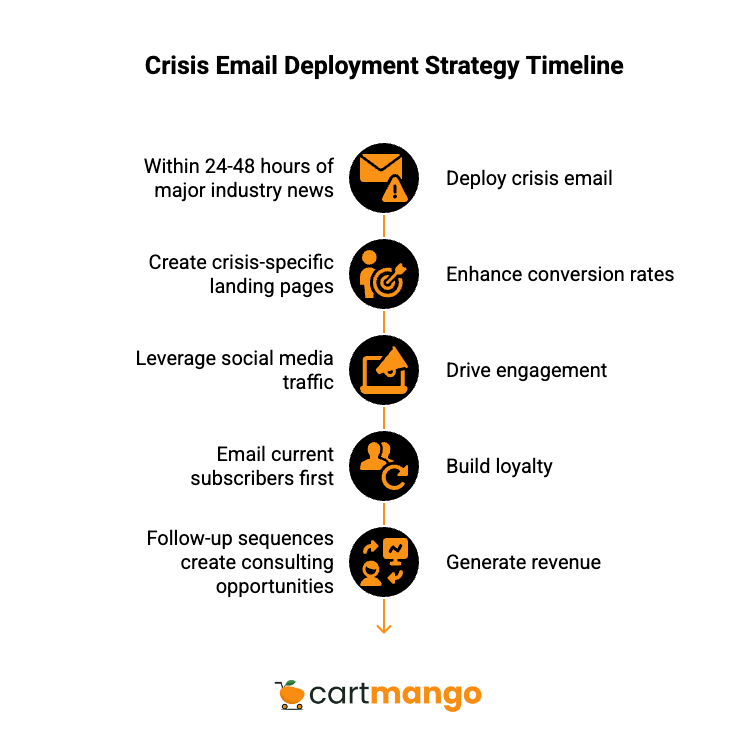
Move within 24-48 hours of major industry news.
Speed establishes you as the go-to expert when business leaders need guidance most. Monitor industry publications and set up Google alerts for breaking news.
Create Crisis-Specific Landing Pages: Build dedicated landing pages for each crisis with relevant lead magnets. These pages convert at 3-5x higher rates than generic opt-in forms.
Leverage Social Media Traffic: Share crisis insights on social platforms with links back to your crisis-specific landing pages.
Email Current Subscribers First: Send crisis analysis to existing subscribers, then use that content to attract new subscribers through social media and content marketing.
Follow-up sequences create crisis-specific consulting opportunities. One well-timed crisis email can generate six-figure consulting engagements from business leaders seeking guidance.
Consultants who leverage market disruptions position themselves as essential strategic advisors rather than optional service providers.
The pain people feel during crisis creates urgency for outside expertise. Your email timing can make the difference between landing the project or watching it go to a competitor.
Crisis emails should offer perspective without being alarmist. Decision makers want calm analysis, not panic-inducing predictions. Balance concern with optimism and actionable recommendations.
Advanced Considerations: When to Scale Beyond DIY
After successfully implementing your 30-day foundation and maintaining consistency for several months, you’ll eventually face growth decisions that go beyond basic email marketing strategy.
This natural progression point is where many consultants consider whether to expand their marketing strategy internally or seek external support.
Some consulting firms reach capacity with their current email marketing platform and need more sophisticated email marketing software. Others find their business goals require expertise beyond what they can develop internally given resource constraints. Understanding these decision points helps you plan your growth path strategically.
The key is recognizing when your success creates complexity that requires either significant time investment or professional expertise to manage effectively. Neither choice is right or wrong – it depends on your specific situation and strategic approach to growth.
Evaluating Email Marketing Consultants and Services
When your email marketing campaign volume outgrows your capacity, email marketing consultants become a viable option. The decision to work with email marketing consulting services or email marketing agencies should align with your business goals rather than just convenience.
Look for consultants with extensive experience working with many clients in similar situations who can provide a detailed strategy tailored to your needs. The best partnerships happen when you find someone well versed in industry best practices who has a proven track record of helping consultants deliver results.
Client feedback and regular reporting become essential when working with external partners. You want consultants who provide actionable insights rather than generic advice. Make sure everyone stays on the same page about expectations and how success gets measured.
The main point is that external support should accelerate your progress, not replace your understanding of what works for your specific target audience. Your brand story and relationship with potential customers remains uniquely yours.
Selecting Advanced Email Marketing Tools
As your email marketing matures beyond the basic BirdSend setup, you might need more sophisticated email marketing software. The right email marketing tool becomes a powerful email marketing tool when it matches your growing complexity without overwhelming your workflow.
Your email marketing service should handle marketing automation while requiring minimal effort to maintain. Platforms like Campaign Monitor and Active Campaign offer advanced features that integrate seamlessly with your digital marketing strategy.
The most important tools focus on being cost effective while providing capabilities like advanced lead capture, pop ups, and integration with other marketing channels. Choose an email marketing platform that reduces resource constraints while improving your ability to generate qualified leads.
Remember that sophisticated tools only help if they align with your strategic approach. The platform should enhance your ability to understand previous interactions and guide prospects through their customer journey rather than complicating your process.
Integrating Email with Your Complete Digital Marketing Strategy
Your email marketing strategy should integrate seamlessly with your broader digital marketing strategy and overall marketing strategy. Each email marketing campaign becomes part of a larger email program designed to guide your target audience through their complete customer journey.
Effective lead generation transforms sales prospects into potential customers and eventually drives more sales for your consulting practice. Your brand story should weave through every touchpoint, building on previous interactions while respecting your resource constraints.
This integration means your email efforts should drive website traffic, support your sales team activities, and provide actionable insights about what resonates with your audience. Email marketers who treat email as an isolated activity miss opportunities to amplify results across all marketing channels.
The strongest strategies acknowledge that consulting emails operate differently than general business communications. Following email marketing best practices means adapting general advice to your relationship-building context rather than copying what works for product companies.
Measuring Performance and Optimizing for Long-Term Results
Track your email campaign performance using actionable insights that connect email efforts to business outcomes. The main point isn’t just open rates – it’s whether your emails capture the recipient’s attention and drive meaningful results.
Monitor how emails drive website traffic and contribute to your broader digital marketing efforts. Calculate your email ROI accurately by connecting email activities to consultation bookings and project wins. This approach helps you improve performance systematically rather than guessing what works.
Focus on metrics that help you understand which messages resonate with your target audience and drive more sales. Regular reporting should track both email-specific metrics and broader business impact to give you a complete picture of effectiveness.
Following best practices means adapting general industry best practices to your specific consulting context. What works for other email marketers might not work for consulting emails, so always filter advice through your relationship-building lens.
The Anti-Newsletter Manifesto: Why Traditional Email Marketing Kills Consulting Businesses
Understanding what NOT to do becomes as important as implementing these strategies. This philosophical foundation separates relationship builders from mass marketers.
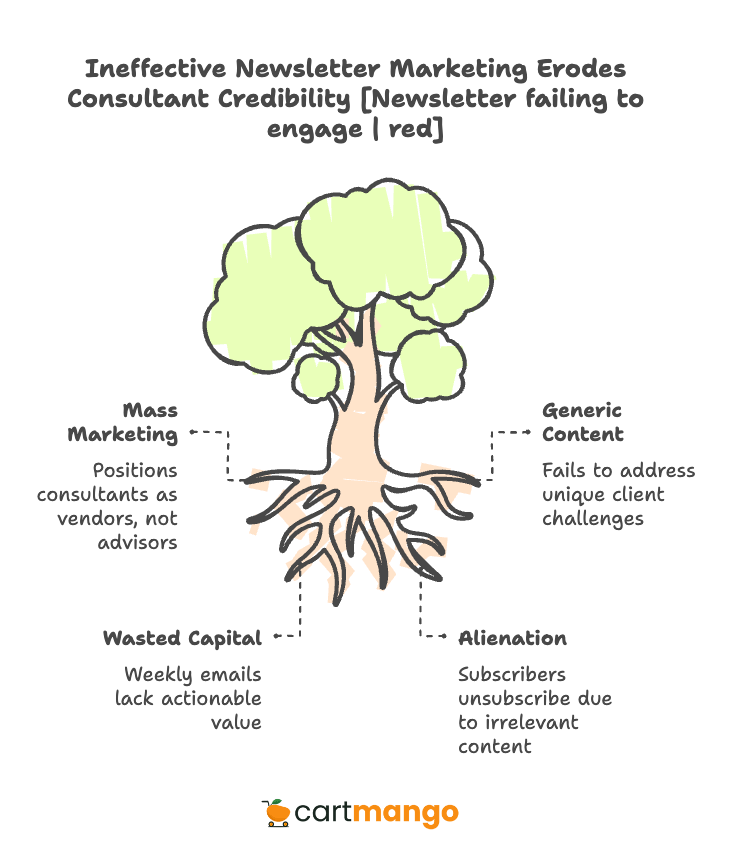
The Newsletter Trap (And Why It Destroys Consultant Credibility)
Mass marketing mistakes position you as a vendor rather than an advisor. Generic newsletters scream “I don’t understand your specific challenges” to business leaders who deal with unique problems daily.
Relationship destruction happens when weekly content emails waste precious relationship capital. Subscribers stop opening your emails after the third generic industry update that provides no actionable value.
Alienation occurs when they unsubscribe from “newsletter noise” immediately. They want strategic insights tailored to their situation, not mass-produced content.
The Personal Email Advantage
One-to-one communication maintains advisor-level positioning. Personal emails feel like strategic counsel rather than marketing campaigns designed to capture leads.
Strategic timing means sending emails when you have something valuable to say rather than following arbitrary schedules. Quality trumps frequency every time in professional relationships.
Professional respect flows to consultants who prefer personal communication over mass marketing. Decision makers want to feel special, not part of a mass list receiving identical content.
Breaking the Email Marketing Rules for Consultants
Quality over frequency works better for relationship-based businesses. Send four perfect emails instead of twenty mediocre ones that dilute your message and annoy recipients.
Personal beats polished when communicating. They prefer authentic insights over marketing copy that sounds like it came from a template or was written by committee.
Strategic beats systematic for consulting businesses. Respond to opportunities and market changes rather than following rigid content calendars that ignore current events.
The newsletter trap catches consultants who think bigger lists always mean bigger revenue. For consultants, a smaller list of high-quality professional contacts who explicitly opted in outperforms massive lists of unqualified subscribers.
Email Marketing for Consultants: Your Turn
Start with Week 1 tomorrow. Set up your foundation properly with legitimate opt-in processes and the rest becomes easier. Your future self will thank you for building an email list the right way from the beginning.
The transformation from struggling consultant to trusted advisor happens through consistent relationship building with people who actually want to hear from you. These email strategies provide the framework, but your expertise and authenticity create the results.
Related
- Gumroad vs Sellfy: The Vendor Lock-in Cage (2025)
- Gumroad vs Payhip: The Hidden Trap for Creators (2025)
- ThriveCart vs SamCart – The Subscription Hostage Trap (2025)
- 8 ThriveCart Alternatives & The Lifetime Pricing Paradox (2025)
- 8 SamCart alternatives + Subscription hostage (2025)
- The GENTLE Method: Soft marketing for creators
- How Far in Advance Should You Promote a Webinar?
- The SAVINGS Method: The Productivity Improvement Plan for Creators
- 9 Questions to Ask: How to Hire a Digital Marketing Agency
- Decision That Costs Millions? Marketing Funnel vs Customer Journey
